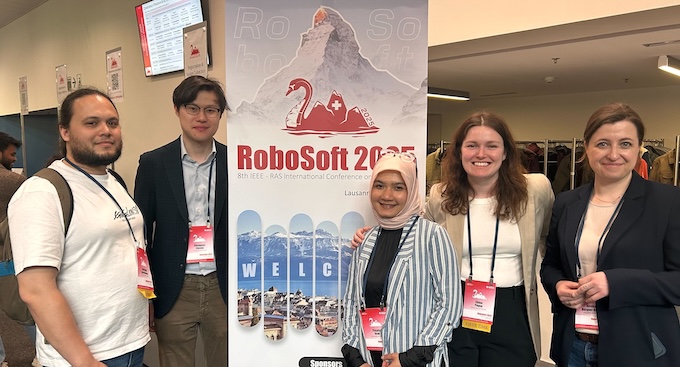
Soft robotics is transforming how machines interact with the world – leveraging flexibility and adaptability to create safer, more responsive technologies with applications in fields such as healthcare and manufacturing.
In April, researchers from the University of Toronto Robotics Institute joined global leaders in Lausanne, Switzerland for the 2025 IEEE – RAS International Conference on Soft Robotics (RoboSoft) – the top international conference on soft robotics.
At the conference, Robotics Institute faculty and graduate students were recognized for their research contributions and strengths in this rapidly growing interdisciplinary field.
Professor Jessica Burgner-Kahrs, associate director, University of Toronto Robotics Institute and director, Continuum Robotics Lab (CRL), chaired the continuum robots track, and was one of 13 expert speakers selected for the workshop, Bridging Computational Disciplines for Motion Generation in Soft Robotics and Deformable Systems. The workshop brought together industry and academic experts to identify solutions to motion planning challenges in soft robotics.
Reinhard Grassman, who recently finished his PhD in the CRL, presented at the Benchmarking in Soft Robotics workshop, which looked at methods of standardizing data collection and the evaluation approach to accelerate progress in soft robotics.
Two graduate student papers were also named to a spotlight shortlist of 40 papers, selected from 400 submissions, for their strong reviews and high rankings, including Grassman, and Katie Allison, a recent MASc graduate of the STARS Lab.
Grassman’s paper, Clarke Transform and Encoder-Decoder Architecture for Arbitrary Joints Locations in Displacement-Actuated Continuum Robots, explores a new method for controlling soft, jointed robots, even when their joints are not evenly spaced. The paper outlines a system that allows robot designs with different joint layouts to share data and control strategies making it easier to reuse algorithms across different robot types, even in robots with more complex or uneven joint setups.
Allison’s paper, Structured Pneumatic Fingerpads for Actively Tunable Grip Friction, examines a low-cost, easy-to-repair gripper fingerpad design that can change grip conditions during object manipulation by adjusting grip friction. Inspired by soft robotics, the hybrid rigid-soft design uses air pressure to change the shape of the fingerpad’s surface, making it either higher- or lower-friction depending on the task.
Puspita Triana Dewi, Jimmy Shentu and Chloe Pogue from the CRL, as well as Majid Roshanfar from the Diller Microrobotics Lab, also presented their research at the conference in interactive sessions. This included the following papers:
- Puspita Triana Dewi, Chloe Pogue, Jessica Burgner-Kahrs: Parametric Design of a Tendon-Driven Continuum Robot for Industrial Applications
- Maximilian Hachen, Chengnan (Jimmy) Shentu, Sven Lilge, Jessica Burgner-Kahrs: A Non-Linear Model Predictive Task-Space Controller Satisfying Shape Constraints for Tendon-Driven Continuum Robots
- Chloe Pogue, Sven Lilge, Eric Diller, Jessica Burgner-Kahrs: Improving Continuum Robots’ Stiffness through Joining
- Majid Roshanfar, Alex Zhang, Changyan He, Amir Hooshiar, James Drake, Thomas Looi, Eric Diller:
Soft Magnetically Steerable Suction Device for Endoscopic Endonasal Brain Tumor Extraction
From shaping technical conversations to earning top recognition for student research, RoboSoft 2025 highlights U of T’s leadership in developing innovative soft robotics solutions.